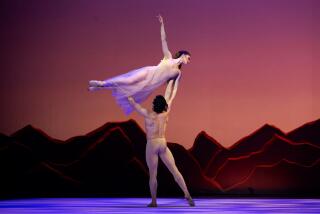TV Reviews : The Heat and Flow of Glen Tetley’s ‘La Ronde’ on Bravo Cable
In the age of AIDS, any story about a chain of promiscuity linking all levels of society will certainly hold our attention. Yet Glen Tetley’s one-act 1987 ballet “La Ronde” doesn’t focus on sexuality so much as on the expressive possibilities of the classical pas de deux.
Danced splendidly by National Ballet of Canada tonight at 7 and midnight on Bravo cable, the nearly hourlong work takes its title, characters and form from the epochal psycho-sexual drama by Arthur Schnitzler, written almost a century ago.
As in Schnitzler, we see a liaison between a Viennese prostitute (Ronda Nychka) and a soldier (John Alleyne) and then watch another between that soldier and a parlormaid (Kimberly Glasco)--the circle widening as we follow the erotic impulse through the world of the middle class, the arts and the nobility until the final player, a count, ends in the arms of the prostitute.
Tetley skillfully condenses character into gestural motifs--the narcissistic preening of the Young Gentleman (Rex Harrington), for instance--and links the episodes cinematically by cross-fading from one conquest (and location) to the next. He even draws the sexual circle twice by summarizing all the relationships in a supercharged group finale.
But there’s no time to savor the manipulation and self-deception of these people as they fling themselves at one another. Moreover, many of the encounters prove ill-suited to the accompaniment: Erich Wolfgang Korngold’s Sinfonietta, Opus 5.
For no evident reason, a domestic scene between the Young Wife (Martine Lamy) and the Young Husband (Peter Ottmann) ends up strangely grandiose and a meeting between the Poet (Owen Montague) and the Sweet Young Thing (Kim Lightheart) resembles Imperial Russian classicism at its most sumptuous.
The best known dancers to U.S. audiences are Karen Kain (flamboyant as the Actress) and Frank Augustyn (magnetic as the Count), but Nychka’s pliancy and Glasco’s radiance are not to be denied. Although he loses the shape of the recapitulation ensemble, Norman Campbell’s TV transcription expertly captures the heat and flow of the 10 showpiece duets--but without making Tetley’s deepest ambitions seem more than fitfully realized.
More to Read
The complete guide to home viewing
Get Screen Gab for everything about the TV shows and streaming movies everyone’s talking about.
You may occasionally receive promotional content from the Los Angeles Times.






